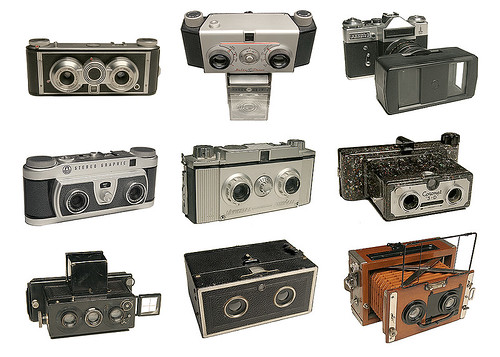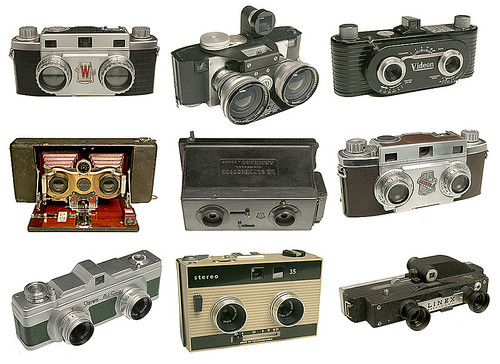Stereo
Stereo photography, stereoscopic photography or stereo for short, is a technique in which two photographs of the same scene are taken from slightly different perspectives, imitating the way the left and right eyes each see the same things from slightly different points of view. The aim of this technique is to mimic human three-dimensional vision. When the pair of images is viewed through a stereo viewer (stereoscope), the left picture shown to the left eye and the right picture to the right eye, the illusion of depth is achieved.
The two pictures are usually taken at the same time, with a camera designed or modified for this purpose, though other methods can be employed to accomplish similar results.
|
| ||||
|
Many types of stereo camera | |||||
History
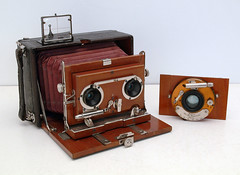
|
| Ernemann Heag III Stereo Camera image by Geoff Harrisson (Image rights) |
There were three major periods when stereo photography and stereoscopy was very much in fashion. The first one began in 1851, just 4 years after the invention of the stereo camera by Scottish physicist Sir David Brewster and Parisian Jules Dubosq. It began with the presentation of the invention to Queen Victoria at the Universal Exhibition of London in 1851. Of course professional photographers were dominating this first stereo photography period, using the early photographical processes like daguerreotype or calotype, but all one standard format: 85×170mm. Every better household had its own stereoscope for this format.

|
| Stereo Kodak Model 1 (1917-25) image by Geoff Harrisson (Image rights) |
The second stereo photography era began at the turn from 19th to 20th century, when commercial stereo cameras, such as Jules Richard's Verascope or the Kodak Brownie Hawkeye Stereo (Models 1, 2, 3 and 4), were widely available.
The third period started in the 1950s when the Stereo Realist brought on another boom of stereo cameras. A small resurrection occurred in the mid-1980s when Nimslo and Nashika cameras became available, offering lenticular printing to the general public. Currently, a smaller boom of stereo cameras is happening with new cameras being made, such as the 3D World TTL-120 medium format camera and the Horseman. Because of price, the new cameras are marketed mainly at a professional market rather than the hobbyist.
The main formats for stereo photography at the beginning of the 20th century were 6x13cm and 45×107mm for a pair of glass plate photos. In the 1950s the cameras tended to adopt some variation around the 24×23mm size per picture on regular 35mm film.

|
| slide viewer |
A timeless stereo slide format is the Viewmaster disc with seven stereoscopic pairs of 12.9×11.9mm slides. The slides are cut from developed 35mm slide film. The Sawyer's Viewmaster camera uses the upper half of a film roll when it is advanced forward, and the lower half when the upper half is full and the film advance switched to backward. Thus 70 stereoscopic slide pairs can be made on one 36 exposure film roll.
Methods of Photography
Stereo Camera
The easiest method is to use a stereo camera. Stereo cameras are made with two or more lenses, depending on the desired output. For most uses, only two lenses are needed. However, for lenticular printing (or use of an autostereosopic monitor), while two lenses can be used, three or more lenses are preferred in order to widen the angle of viewing. This is also one of the best methods for taking photos of objects in motion.
Some stereo cameras are made by joining two or more cameras together. RBT is an example of this type of camera.
Cha-Cha
Cha-cha, also known as the astronaut shuffle, is the method of taking a photo, moving the camera to the right slightly, and then taking a second photo. The disadvantage of this is that this method is only good for non-moving objects, such as a landscape or architecture.
While this can be done freehand, a more precise way of taking a cha-cha photo is to use a slide bar, which will put the camera at exactly the place you need it to be.
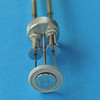
|
| Gitzo dual cable release |
Twinning
Twinning is the act of placing two cameras side by side for the photo. This is usually a good alternative to cha-cha for digital stereo photographers, though it is a more expensive route. Twinning bars for various camera sizes are available that will place the lenses level and at the appropriate distance. Then, the cameras' shutters are released simultaneously by either manually pushing the shutter release on both cameras at the same time or, preferably, using a modified cable release that will sync the two cameras. This was sometimes done commercially - perhaps with very cheap cameras, for example Universal produced the Duovex - two $0.39c Univex Model A cameras fixed together.
Types of Stereo
Most stereo cameras will try to mimic the distance between the human eye. However, the human eye is insufficient for some photography.
Macro Stereo
With a macro stereo, lenses are placed very close together in order to take a photo of very small subjects in stereo. With cha-cha, this can be achieved by moving the camera over only very slightly or rotating the object slightly. Macro stereo cameras have been made by RBT and David White Co.
Hyperstereo
This method can only be done with cha-cha or twinning as the distance needed for a hyperstereo photo is much wider than a human eye. Hyperstereo is best for landscapes and cityscapes where a normal stereo photo would show absolutely no depth. Distance between two cameras depends on the subject. For example, doing a cityscape might only mean that you would need to take two photos on a roof with one camera at each end of the building, thus creating a lens separation of several feet.
Lenticular Stereo
see Nimslo
Viewing and Presentation Methods
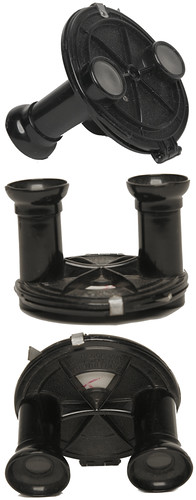
|
| Sawyer's stereo viewer image by Rick Soloway (Image rights) |
Stereo Cards
One of the oldest methods is a printed photo. These were very popular in the late 19th century up until the 1940s when View-Master became the popular format. For medium format photography, this method only requires a contact print.
Stereo Slides
The most popular method, stereo slides are slides that are mounted in a stereo mount, such as a Realist-format mount or a View-Master reel.
Anaglyph
Requires a pair of glasses, but can be viewed in print, on a monitor, or projected. Glasses in anaglyphs are usually tinted red and cyan, but red and green or red and blue are other options. This is the method that most people mistakenly associate with 3-D movies of 1953 (most movies produced in the 3-D movie boom of 1953 were polarized stereo). The disadvantage of anaglyphs is that the red tinting of the glasses gives many people eye strain or headaches after extended use.
Lenticular Printing
This method is capable of free-viewing without the need for a viewer or glasses. In lenticular prints, multiple images are interlaced and then a plastic sheet is placed on top of the print. This is a popular method for movie posters, advertisements, and other areas where glasses or a viewer might not be desirable. Also frequently used to show simple animations.
Projection
Projection is usually done by twining a pair of projectors or by using a stereo projector. The lenses of the projector are polarized so that when the polarized glasses are worn, they will give a very clear representation of the picture. However, a normal screen cannot be used. Only a silver screen is capable of the projection of stereo photography.
Polarization is the method currently used in digital 3-D movies as well as most stereo movies of the 1953 3-D boom.
As mentioned above, anaglyphs may also be projected.
Autostereoscopic Monitors
Based on lenticular technology, this is a more recent development of viewing 3-D imagery without the need for glasses. Autostereoscopic monitors are still in their infancy, but improvements are coming all the time for improved viewing of 3-D viewing on a TV or computer without glasses. Autostereoscopic televisions are available up to 65".
Notable Stereo Photographers
- Jacobus G. Ferwerda
- William Gruber, inventor of View-Master
- Harold Lloyd
- Christopher Schneberger
- Vladimir
- Pat Whitehouse
Bibliography
- Waldsmith, John S. Stereo Views: An Illustrated History and Price Guide. Krause Publications, 2nd edition, 2003. 336 pages.
- Auer, Michel "150 ans d'appareils photographiques", 1989
Links
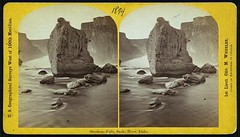
|
| Shoshone Falls, Snake River, Idaho, 1874 stereo image by T.H. O'Sullivan,(Image rights) |
- Stereoscopy.com
- Berezin Stereo, Stereo Photography Supplier
- ViewMasterResource.com
- Stereo camera instruction manuals, PDF format, many with color at Mike Butkus' Orphan Cameras
- nice stereo camera collection of Stereoskopklubben, Denmark
- Animated stereo images - a set at Thiophene-guy's Flickr account. The two stereo parts of the photographs are presented alternately in a .gif animation. The photographs are mostly from the Library of Congress.
